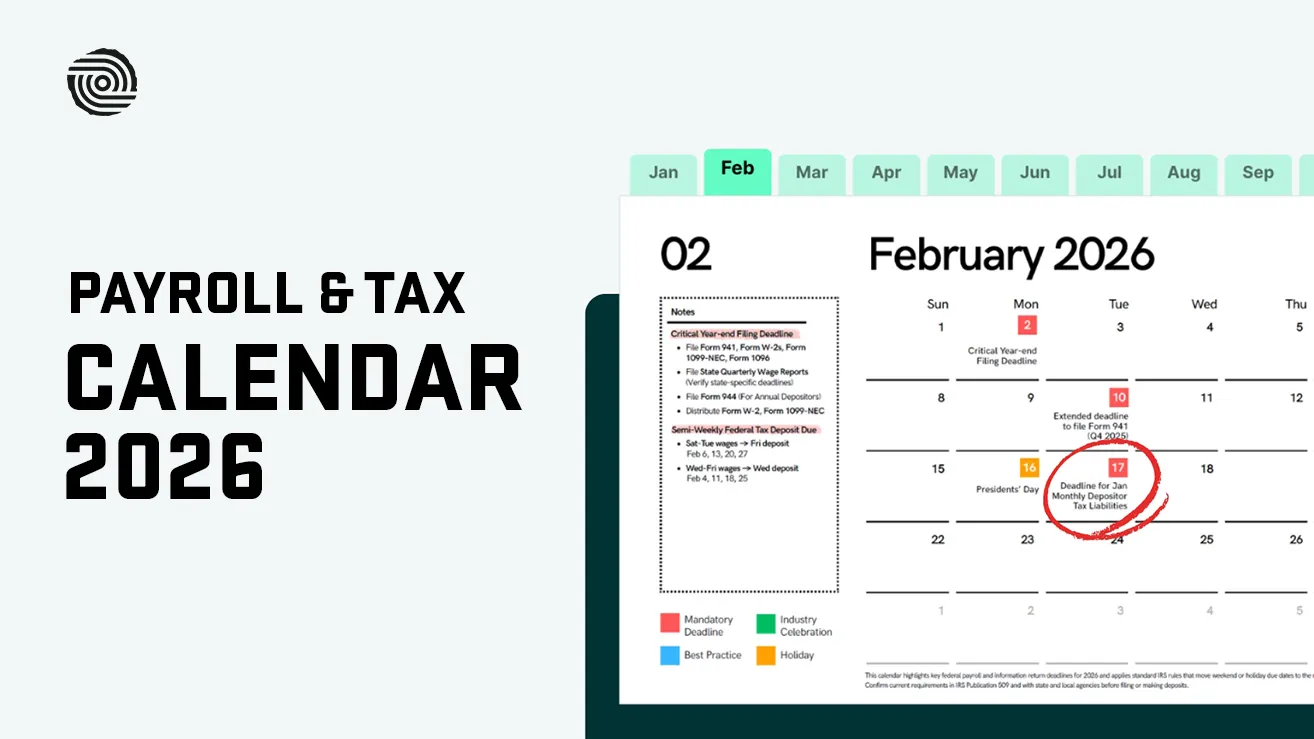The Importance of Proper Employee Classification for Construction Payroll


Navigating the intricacies of construction payroll can often feel like a labyrinth, especially as regulatory landscapes continue to evolve. For construction firms, proper classification of employees' payroll is more critical than ever. This not only impacts how you manage your payroll but can also have significant repercussions when done wrong. Even a minor misstep could lead to costly penalties, audits, or legal disputes—penalties that have grown substantially in recent years.
Recent enforcement actions underscore the severity of this issue.
In 2024, electrical subcontractor Power Design agreed to pay $3.75 million, the largest workers' rights recovery in Washington, D.C.'s history, after city investigators revealed widespread worker misclassification. That same year, Illinois construction company TBJ Drywall agreed to repay $718,000 in unpaid wages after misclassifying over 480 employees between 2018 and 2023.
Understanding and correctly applying employee classification in the construction industry should be a top priority for any business owner or payroll manager. This comprehensive guide will unravel the complexities of this issue, offering valuable guidance for those in the construction sector navigating the rapidly changing compliance landscape of 2025.
Definition of Proper Employee Classification
In simple terms, employee classification is categorizing your workforce into specific groups based on job role, pay rate, and position status (exempt or non-exempt), among other factors. Correctly classifying employees is crucial not just for managing a smooth payroll process but also for staying compliant with federal, state, and local labor laws—laws that have become increasingly stringent in recent years.
Why Employee Classification Matters More Than Ever in 2026
The importance of proper employee classification in construction payroll cannot be overstated, particularly given recent regulatory changes and enforcement priorities:
- Accurately determines wages, overtime payments, and benefits for each employee.
- Prevents legal consequences for wrongly classifying workers—consequences that have grown more severe.
- Ensures business compliance with evolving federal, state, and local labor laws.
- Protects your competitive position by preventing competitors from gaining unfair cost advantages through worker misclassification.
- Contributes to a better, more organized workplace where everyone knows their role and receives proper protection
Since January 2021, the U.S. Department of Labor has recovered over $41 million in back wages for more than 28,000 workers who were misclassified as independent contractors. This aggressive enforcement trend shows no signs of slowing.
Understanding the Current Regulatory Landscape

The Evolving Federal Standard
The federal standard for determining independent contractor status has undergone significant changes in recent years. In January 2024, the Department of Labor issued a final rule that adopted a six-factor "economic reality" test to determine worker classification under the Fair Labor Standards Act (FLSA). This rule took effect on March 11, 2024.
However, there's a critical development: As of May 2025, the DOL announced it would no longer enforce the 2024 rule. Instead, DOL investigators now apply traditional "economic realities" principles based on earlier guidance from 2008 and a 2019 opinion letter. While the 2024 rule technically remains in effect for private litigation, the DOL has paused its enforcement pending potential revision or rescission.
What this means for construction companies: The classification landscape remains in flux. While federal enforcement has shifted to a more business-friendly approach, the 2024 rule can still be cited in private lawsuits. More importantly, many states have their own—often stricter—classification standards that are actively enforced.
The Traditional Economic Realities Test
Under the current DOL enforcement position, investigators evaluate several factors to determine whether a worker is truly in business for themselves or dependent on the hiring entity:
- The nature and degree of control by the principal
- The worker's opportunity for profit or loss depends on managerial skill
- The worker's investment in equipment or materials
- Whether the work requires special skills and initiative
- The permanence of the working relationship
- The degree to which the work is an integral part of the principal's business
- The degree of independent business organization and operation
No single factor is determinative—the overall relationship must be examined to determine if the worker is economically dependent on the employer or truly in business for themselves.
State Standards: The ABC Test and Beyond
While federal standards matter, many states impose significantly stricter classification requirements. Understanding your state's specific rules is essential.
States Using the Strict ABC Test (includes but is not limited to):
- California
- Massachusetts
- New Jersey
- Connecticut
- Illinois
- Washington
- Vermont
Under the ABC test, a worker is presumed to be an employee unless the employer can prove ALL three of the following conditions:
A. Absence of Control: The worker is free from the control and direction of the hiring entity in connection with the performance of the work, both under the contract and in fact.
B. Business of the Worker: The worker performs work that is outside the usual course of the hiring entity's business. (This is often the most challenging prong for construction companies to satisfy.)
C. Customarily Engaged: The worker is customarily engaged in an independently established trade, occupation, profession, or business of the same nature as that involved in the work performed.
The ABC test is notably more restrictive than the federal economic reality test. A worker might qualify as an independent contractor under federal law but still be considered an employee under state law. When state and federal standards conflict, you must comply with whichever standard is more protective of workers.
States Using Common Law Test (includes but is not limited to):
- Alabama, Arizona, Florida, Iowa, Kentucky, Michigan, Minnesota, Mississippi, Missouri, New York, North Carolina, North Dakota, South Carolina, South Dakota, and Texas
The Common Law test generally presumes a worker is an independent contractor unless specific standards prove otherwise, focusing primarily on the degree of control exercised by the employer.
Different Types of Worker Classifications
.webp)
There are primarily four types of worker classifications in the construction industry:
Temporary Employees
Temporary employees, commonly sourced from agencies, leasing companies, or staffing companies, are individuals designated as such because of their work arrangement. It's important to note that your organization does not technically employ them; rather, the staffing company provides its services to your specific project.
Despite this distinction, remain vigilant about the precise nature of their employment. In certain cases, you may be deemed a "joint employer," thereby assuming legal responsibility for any discriminatory actions committed by your supervisors against these employees. This joint employer liability has become a significant enforcement focus in recent years.
Temporary employees typically have limited job security and do not receive fringe benefits through your firm. However, as the worksite employer, you still have responsibilities for workplace safety and compliance with certain labor standards.
Independent Contractors
Unlike employees, independent contractors run their own business. They are not entitled to the same benefits offered to an employee, but they enjoy more freedom and flexibility. The relationship between an employer and an independent contractor is minimal due to the independent nature of the role.
To determine if a worker truly qualifies as an independent contractor, consider the following factors:
Level of control: If the worker has genuine autonomy over their work-related tasks**, including when, where, and how the work is performed**, they may be classified as an independent contractor.
Ability to work on unrelated projects: If the worker can work on multiple projects with different clients simultaneously without your permission, they likely qualify as an independent contractor.
Use of personal resources: If the worker is responsible for providing their own equipment, covering their own expenses, and making entrepreneurial investments in their business, they may be categorized as an independent contractor.
Business operations: Does the worker advertise their services, maintain business insurance, have their own business cards and website, and operate like an independent business?
This distinction means that the majority of federal and state laws that protect traditional employees do not apply to independent contractors. Instead, independent contractors are considered to be "self-employed." As a result, companies that hire independent contractors do not have the authority to directly control or supervise their time, work performance, method of work**, or working conditions**.
Critical Warning: Simply calling someone an independent contractor, having them sign an independent contractor agreement, or issuing them a 1099 form does not make them one. Classification depends on the actual working relationship, not labels or paperwork. Courts and agencies look at the economic reality of the relationship, not the parties' intent or agreement.
Employees

In contrast to independent contractors, employees are individuals directly hired by an employer and are on the employer's payroll, entitled to all benefits and protections under labor law. Most employment relationships in the United States follow the employment-at-will doctrine, which allows both the employer and the employee to terminate the relationship at any time without cause, provided it is not in violation of the law. However, employees who are terminated without just cause may be eligible for unemployment compensation benefits.
As an employer, it is your responsibility to provide your employees with the necessary tools, equipment, and safety gear to perform their jobs effectively. Additionally, you must compensate them according to either the federal minimum wage (currently $7.25/hour, though many states have higher minimums) or the local prevailing wage for government-funded projects, whichever is higher.
Important Employer Rights and Restrictions: While employers generally have the right to terminate employment at will, it is essential to exercise this power judiciously**. A reputation for frequent terminations can make it challenging to attract and retain a skilled workforce, especially in today's competitive labor market.**
You cannot terminate an employee based on protected characteristics, including gender, religion, ethnicity, age (40 and over), disability, pregnancy, genetic information, or other protected categories under federal and state law. Furthermore, employees who serve as jury members are protected and cannot be terminated for taking time off for jury duty. Employees are also protected from retaliation for engaging in protected activities such as reporting safety violations, filing workers' compensation claims, or discussing wages with coworkers.
Union Employees
The rights of union employees depend on the collective bargaining agreement (CBA) established between their union and employer. Also known as a contract, the CBA outlines the actions they can take and the circumstances under which they can take them. This is different from non-union employees, who are typically governed by the employment-at-will doctrine.
If you employ union employees, you will generally need to provide a valid reason, often referred to as "just cause," for terminating their employment. You may need to issue written warnings and record them as evidence of your cause for termination. To ensure adherence to industry standards and prevent disruptions to projects, you may need to follow progressive disciplinary measures as outlined in the CBA. This approach informs employees of best practices and helps maintain project stability.
Multi-Employer Pension Plans: If you work with unionized employees, you may have obligations to contribute to multi-employer pension plans. These obligations can continue even after you've completed a project, and withdrawal liability can be substantial. Ensure you understand your obligations and budget accordingly.
Project Labor Agreements: Some public and large private projects require contractors to sign project labor agreements (PLAs) that establish specific terms for union employment on the project. Understanding these agreements is essential for accurate bidding and compliance.
Key Considerations for Payroll Classification

When classifying workers for payroll purposes, consider the following:
Hourly vs. Salary
Workers are typically categorized as either hourly (paid by the hour) or salaried (paid a fixed salary regardless of hours worked). This distinction is often based on the nature of the work and legal requirements under FLSA exemption rules.
Overtime Eligibility
Some workers are eligible for overtime pay (usually 1.5 times their regular rate) when they work more than 40 hours per week under federal law, or more than 8 hours per day in some states, such as California. Others may be exempt from overtime based on their job duties**, responsibilities,** and salary level meeting specific legal tests (executive, administrative, professional, computer, or outside sales exemptions).
Common Misunderstanding: Paying a salary does not automatically make an employee overtime-exempt. The employee must meet specific duties tests and minimum salary thresholds.
Full-Time vs. Part-Time
Workers may be classified as full-time or part-time employees, affecting their benefits and compensation structures. While there's no universal definition, the Affordable Care Act considers 30+ hours per week as full-time for benefits purposes.
Union vs. Non-Union
Workers who are members of labor unions may have different payroll structures, benefits, and workplace protections compared to non-union workers, as governed by their collective bargaining agreements.
Independent Contractors
Some workers may be classified as independent contractors rather than employees, which has significant implications for payroll**, tax requirements, workers' compensation, and unemployment insurance. However, misclassification in this category is where most legal problems arise.**
Pay Grades and Classification Systems
Companies often establish pay grades or pay scales based on factors like experience, qualifications, and job responsibilities. Workers are then assigned to these pay grades for payroll purposes. Ensure your classification system aligns with prevailing wage requirements for government-funded projects.
Bonuses and Incentives
Depending on performance, workers may receive bonuses, commissions, or other incentives, which need to be factored into regular rate calculations for overtime purposes.
Deductions and Withholdings
Payroll classifications must account for deductions for federal and state taxes, Social Security, Medicare, health insurance, retirement contributions**, union dues,** and other withholdings.
Special Payroll Codes
Construction firms may use special payroll codes for specific roles or circumstances, such as hazard pay for workers in hazardous conditions or premium pay for certain job classifications under prevailing wage requirements.
State and Local Regulations
Payroll classifications must consider state and local labor laws, which can vary widely and may impact minimum wage, overtime rules, paid sick leave, and other factors. Some jurisdictions have specific protections for construction workers that exceed federal standards.
Common Misconceptions About Employee Classification
.webp)
Misconception #1: We can decide to classify someone as an independent contractor.
Reality: Classification is determined by labor laws and actual working conditions, not by the employer's preferences or agreement with the worker.
Misconception #2: If they sign an independent contractor agreement, they're a contractor.
Reality: Courts and agencies look at the actual working relationship, not the paperwork. A contract that declares someone an independent contractor carries little weight if the working relationship resembles employment.
Misconception #3: We only use them occasionally, so they must be contractors.
Reality: Frequency of work is just one factor. Even occasional workers can be employees if the other factors point toward employment.
Misconception #4: They have their own tools, so they're contractors.
Reality: Tool ownership is one factor, but many construction employees own their own hand tools. The question is whether they've made substantial entrepreneurial investments in equipment that extend their market reach.
Misconception #5: They work for other companies too.
Reality: Working for multiple clients supports independent contractor status, but isn't determinative, especially if you exercise significant control over how they perform work for you.
Misconception #6: They're skilled tradespeople, so they're automatically contractors.
Reality: Skill level alone doesn't determine status. Many highly skilled workers are employees.
Recent Enforcement Actions: What's at Stake
Understanding the real-world consequences of misclassification is essential. Here are recent enforcement actions that demonstrate the stakes:
Power Design Settlement (2024) - $3.75 Million
In Washington D.C.'s largest workers' rights recovery, electrical subcontractor Power Design paid $3.75 million for misclassifying hundreds of construction workers as independent contractors. The settlement included:
- $1.7 million in restitution to over 1,200 workers
- $1.2 million in penalties to D.C.
- $880,000 in attorney's fees
- Three years of compliance monitoring
- Requirement to stop working with labor brokers who misclassify workers
District of Columbia Multi-Company Lawsuit (2024)
Attorney General Brian Schwalb filed a lawsuit against Whiting-Turner, W.G./Welch Mechanical Contractors, and three labor brokers for a widespread misclassification scheme affecting over 370 construction workers. The lawsuit alleged that labor brokers were used to supply low-cost, misclassified workers, creating a systemic scheme that benefited general contractors through illegally suppressed labor costs.
TBJ Drywall Settlement (2024) - $718,000
Illinois construction company TBJ Drywall agreed to repay $718,000 in unpaid overtime wages after misclassifying over 480 employees as independent contractors between 2018 and 2023. The company paid workers fixed-day rates regardless of hours worked, depriving them of overtime premiums. The consent decree also subjects TBJ to four and a half years of monitoring.
Historical Context
These recent cases follow a pattern of aggressive enforcement:
- 2022: The DOL found 478 Massachusetts construction workers were misclassified, recovering $1.8 million
- 2023: California investigation recovered $650,000 for 26 misclassified delivery drivers
- Since 2021: DOL has recovered over $41 million for more than 28,000 misclassified workers nationwide.
The Economic Impact: Studies show that misclassified construction workers lose between $10,177 and $16,729 per year in income and benefits. For employers who misclassify, the economic analysis shows they can illegally reduce labor costs by 16.7% to 40%, creating an unfair competitive advantage over compliant companies.
Potential Consequences of Improper Employee Classification

From misjudging overtime pay to underestimating workers' compensation, misclassifying employees can have significant, costly impacts on construction payroll.
Financial Penalties and Fines
Incorrectly categorizing employees can lead to devastating financial consequences. Both the IRS and Department of Labor along with state agencies, have strict regulations regarding employee classification. Failures to comply can result in:
Federal Penalties
- Back pay for wages and overtime (often doubled as liquidated damages under FLSA)
- Unpaid employment taxes (employer's share of FICA)
- Penalty assessments from the IRS range from $50 per Form W-2 to 100% of the tax due
- Fines for violations of labor laws
State Penalties
- California: $5,000 to $25,000 per willfully misclassified worker; $10,000 to $25,000 for repeat violations
- Illinois: Up to $10,000 per misclassified construction worker
- Massachusetts: Treble damages (triple the amount owed) under state wage law
- Many states: Additional penalties for failure to provide workers' compensation coverage
Additional Financial Burdens
- Unpaid unemployment insurance premiums with interest
- Unpaid workers' compensation premiums with retroactive adjustments
- State and local tax liabilities
- Benefits owed (health insurance, retirement contributions, paid leave)
Lawsuits and Legal Disputes

Incorrect employee classification can lead to lawsuits and legal disputes that drag on for months or years, causing significant financial and emotional strain:
- Class action lawsuits: Multiple workers can band together, multiplying your exposure
- Private attorney general actions: In some states, like California, workers can sue on behalf of the state for Labor Code violations
- Joint employer liability: As a general contractor, you may be liable for subcontractors' misclassification
- Criminal prosecution: In egregious cases, company owners can face criminal charges (as happened with the G&R Drywall owner, who received nearly two years in prison)
Damage to Reputation and Business Relationships
Perhaps the most damaging long-term consequence is damage to your reputation. A construction firm with a history of labor law violations faces:
- Loss of trust from current and potential employees: Word spreads quickly about companies that don't treat workers fairly
- Difficulty in competitive bidding: On public projects, compliance violations can lead to debarment or suspension
- Hesitation from potential partners or clients: Many sophisticated clients now require compliance certifications
- Negative publicity: In today's digital age, enforcement actions often receive significant media coverage and social media attention
- Banking and bonding challenges: Lenders and surety companies view compliance problems as risk factors
- Reduced ability to attract talent: In a tight labor market, reputation matters
Competitive Disadvantage
While misclassification might seem to create a cost advantage, lawful competitors can report violations, and once caught, you'll face penalties that far exceed any short-term savings. Moreover, companies with strong compliance records are increasingly winning bids based on their reputation, especially for sophisticated clients and public projects.
Best Practices for Maintaining Proper Employee Classification in 2026

Taking the right steps can greatly simplify the process of properly classifying employees in your construction payroll. This can not only save you from legal troubles but also position your company as an employer of choice.
1. Conduct Regular Classification Audits
Don't wait for a DOL investigation or lawsuit. Conduct internal audits at least annually, or whenever there are significant regulatory changes:
- Review all worker relationships: Don't assume past classifications remain correct
- Document your analysis: Keep written records of the factors you considered
- Focus on high-risk classifications: Pay special attention to workers you've classified as independent contractors
- Use classification questionnaires: Develop standardized questionnaires for new engagements
- Consider third-party audits: For high-risk situations, consider hiring external specialists
Best Practice Timing: Conduct full audits annually, with quick reviews when:
- New regulations take effect
- You enter new states or markets
- Your business model changes
- You establish new subcontractor relationships
2. Maintain Comprehensive Documentation
Excellent record-keeping is not an option—it's essential:
For All Workers:
- Complete job descriptions that accurately reflect actual duties performed
- Time and attendance records
- Compensation records (including all forms of payment)
- Tax documents (W-2s for employees, 1099s for contractors)
- Benefits enrollment or declination forms
For Independent Contractors:
- Written independent contractor agreements that accurately reflect the relationship
- Evidence of the contractor's independent business (business license, insurance, marketing materials)
- Documentation of the contractor working for other clients
- Records showing a lack of day-to-day supervision
- Proof of the contractor's investment in equipment and materials
For Employees:
- Hiring paperwork (Form I-9, W-4, state withholding forms)
- Acknowledgment of employee handbook receipt
- Training records
- Performance evaluations
- Benefits election forms
Auditors may request this information with little notice. Having it organized and readily available can significantly reduce the stress and cost of an audit.
3. Create Clear, Accurate Job Descriptions
It all starts with accurate job descriptions that match reality:
- Define job duties clearly: Be specific about what the worker actually does, not what you wish they did.
- Describe the level of supervision: Document who supervises the worker and how closely.
- Indicate tools and equipment needed: Specify whether provided by the company or the worker.
- Update regularly: Review and revise at least annually and whenever duties substantially change.
- Match descriptions to reality: Ensure the written description matches the actual work performed.
4. Implement a Classification Decision Framework
Create a structured process for classification decisions:
Step 1 - Initial Assessment: Use a classification questionnaire or checklist
Step 2 - Multi-Factor Analysis: Apply the relevant test (federal economic reality, state ABC test, etc.)
Step 3 - Documentation: Document your reasoning in writing
Step 4 - Management Review: Have classifications reviewed by a classification committee or senior management
Step 5 - Legal Review: For borderline cases, seek legal counsel
Create a Classification Committee: For medium to large construction firms, establish a standing committee including representatives from HR, payroll, legal, and operations. This committee should:
- Review all borderline classification decisions
- Ensure consistency across the organization
- Stay informed about regulatory changes
- Conduct or oversee regular audits
5. Stay Informed About Regulatory Changes

Labor laws and regulations are constantly changing, and staying informed is crucial:
Federal Updates:
- Monitor DOL announcements and guidance
- Subscribe to DOL email updates
- Watch for court decisions in your circuit
State and Local Updates:
- Subscribe to state labor department newsletters
- Join industry associations that track regulatory changes
- Attend compliance webinars and workshops
- Work with a legal counsel who specializes in employment law
Current Regulatory Focus (2025):
- The federal enforcement approach has shifted but remains active
- State enforcement has intensified, particularly in ABC test states
- Joint employer liability is a major enforcement focus
- Technology platforms and digital work arrangements face scrutiny
6. Train Your Management Team
Your managers and supervisors must understand classification rules:
Training Should Cover:
- Legal requirements and consequences of misclassification
- The difference between employees and independent contractors
- How much control to exercise (or not exercise) over different worker types
- Proper documentation requirements
- Red flags that indicate potential misclassification
- When to escalate questions to HR or legal
Frequency: Provide initial training for all supervisors and refresher training at least annually.
Practical Scenarios: Use real-world scenarios from your operations to make training relevant and memorable.
7. Properly Structure Independent Contractor Relationships
If you do engage true independent contractors, structure the relationship correctly from the start:
Written Agreements should include:
- Clear scope of work and deliverables
- Acknowledgment that the contractor controls methods and means
- Contractor's responsibility for their own taxes and insurance
- Right of the contractor to work for others
- Contractor's provision of their own tools and equipment
- Payment structure (typically per job or project, not hourly)
- Termination provisions
- Independent contractor status acknowledgment
Working Relationship should reflect:
- Minimal supervision or control
- Contractor's entrepreneurial opportunity for profit or loss
- Contractor's investment in their business
- Non-exclusive relationship
- Contractor's ability to hire helpers
- Contractor working for multiple clients
Critical: The written agreement must match the actual working relationship. Courts and agencies will look at reality, not just paperwork.
8. Exercise Caution with Subcontractors and Labor Brokers
Recent enforcement actions have focused heavily on labor broker schemes and subcontractor misclassification:
Due Diligence on Subcontractors:
- Verify subcontractor has a valid business license and insurance
- Confirm subcontractor is properly classifying their own workers
- Include compliance representations and warranties in subcontracts
- Reserve audit rights in subcontractor agreements
- Consider requiring proof of workers' compensation coverage
Labor Broker Arrangements:
- Be extremely cautious with labor broker arrangements
- Understand that you may be deemed a joint employer
- Recent enforcement actions have targeted these arrangements
- If you are using labor brokers, ensure robust compliance verification
General Contractor Liability: Remember that many jurisdictions hold general contractors liable for wage violations by subcontractors. Due diligence is not just good practice—it's essential protection.
9. Implement Technology Solutions
Modern payroll and compliance software can help:
- Automated classification tools: Some platforms offer AI-powered classification assessments
- Digital time tracking: Accurate time records are essential for wage compliance
- Document management: Centralized storage of classification documentation
- Multi-state compliance: Software that tracks varying state requirements
- Audit trails: Automated tracking of classification decisions and changes
Using AI-powered technology will help support your compliance efforts.
10. Seek Legal Counsel When Needed
Nobody expects you to be an expert in labor laws. When dealing with complicated circumstances for employee classification, seeking legal advice is wise:
When to Consult an Attorney:
- Before implementing new contractor programs
- For borderline classification decisions
- When entering new states with different requirements
- If you receive an audit notice or complaint
- When structuring complex subcontractor arrangements
- For annual compliance reviews
Choosing the Right Attorney: Work with counsel who specializes in construction industry employment law and has experience with worker classification issues in your specific states of operation.
11. Develop a Proactive Compliance Culture
The best protection against misclassification problems is creating a culture that prioritizes compliance:
- Leadership commitment: Make compliance a stated priority from the top
- Open communication: Encourage workers and managers to raise classification questions
- No retaliation: Protect workers who raise concerns about their classification
- Continuous improvement: Treat audits and reviews as opportunities to improve
- Ethical advantage: Frame proper classification as a competitive advantage and point of pride
Remember: Companies that properly classify workers can compete for contracts more confidently, attract better talent, and build stronger reputations. Compliance is not just about avoiding penalties—it's about building a sustainable, ethical business.
Special Considerations for 2026
Multi-State Operations
If your construction firm works across state lines, you face additional complexity:
- Different standards in different states: California's ABC test vs. Texas's common law test
- Registration requirements: Each state may require different registrations
- Prevailing wage laws: Federal Davis-Bacon and state "little Davis-Bacon" acts vary
- Benefits requirements: Paid sick leave, paid family leave vary by jurisdiction
- UI and workers' comp: Different states have different requirements and tax rates
Solution: Maintain state-by-state compliance matrices and ensure your payroll system can handle multi-state complexity.
Technology and Digital Platforms
The rise of digital platforms for finding workers creates new classification challenges:
- App-based worker arrangements: Scrutiny of platform work is intense
- Remote work for certain roles: Project managers, estimators working remotely
- Digital time tracking: Technology can help ensure accurate records
- Data privacy: Consider implications of worker monitoring and surveillance
Emerging Workforce Models
The construction industry is evolving, creating new classification questions:
- On-demand staffing: Short-term engagements and rapid onboarding
- Hybrid arrangements: Workers who transition between employee and contractor roles
- Professional employer organizations (PEOs): Understanding co-employment relationships
- Apprenticeship programs: Proper classification of apprentices and trainees
Climate for Enforcement
Understanding the current enforcement climate helps you assess risk:
Current Trends (2025):
- The federal enforcement approach has shifted to be more business-friendly, but remains active
- State enforcement has intensified dramatically, especially in ABC test states
- Private litigation continues to be extremely active
- Worker awareness of rights has increased
- Social media amplifies enforcement actions and worker complaints
- Industry-wide investigations in construction remain common
Industries Under Scrutiny: Construction, trucking, home healthcare, and gig economy platforms face the most scrutiny. The construction industry's widespread use of subcontracting makes it a constant enforcement target.
The Cost-Benefit Analysis: Proper Classification as Investment
It's tempting to view proper classification solely through the lens of cost and compliance burden. However, consider the positive business case:
Costs of Proper Classification
- Payroll taxes (7.65% FICA)
- Workers' compensation insurance
- Unemployment insurance
- Benefits (if provided)
- Additional administrative burden
Benefits of Proper Classification:
- Avoidance of catastrophic penalties (which can exceed 40% of wages)
- Greater control over quality and methods
- Enhanced reputation and competitive positioning
- Reduced legal risk and stress
- Better ability to attract and retain talent
- Stronger banking and bonding relationships
- Qualification for more projects (especially public works)
- Peace of mind for owners and managers
When you factor in the risk-adjusted costs of misclassification, proper classification is almost always the more economical choice.
As we move to the end of 2025, proper employee classification in construction payroll has never been more critical—or more complex. The regulatory landscape continues to evolve, enforcement remains aggressive at state levels, and the financial stakes have grown substantially.
Key Takeaways:
- Classification is a legal determination, not a business decision. The actual working relationship determines status, regardless of what you call it or what contracts say.
- State laws often exceed federal protections. When federal and state standards conflict, you must comply with the more protective standard. Know your state's requirements.
- Recent enforcement actions demonstrate real consequences: Multi-million dollar settlements, criminal prosecution, years of monitoring, and significant reputational damage.
- Compliance is an ongoing process, not a one-time event. Regular audits, continuous training, and proactive management are essential.
- Proper classification is a competitive advantage. Firms with strong compliance records increasingly win more business, attract better talent, and build stronger reputations.
- When in doubt, seek expert guidance. The cost of proper legal advice is trivial compared to the cost of getting classification wrong.
- Create a culture of compliance. Make proper classification a shared responsibility across your organization, not just an HR or payroll function.
Lorem ipsum dolor sit amet, consectetur adipiscing elit. Donec ullamcorper mattis lorem non. Ultrices praesent amet ipsum justo massa. Eu dolor aliquet risus gravida nunc at feugiat consequat purus. Non massa enim vitae duis mattis. Vel in ultricies vel fringilla.
Introduction
Mi tincidunt elit, id quisque ligula ac diam, amet. Vel etiam suspendisse morbi eleifend faucibus eget vestibulum felis. Dictum quis montes, sit sit. Tellus aliquam enim urna, etiam. Mauris posuere vulputate arcu amet, vitae nisi, tellus tincidunt. At feugiat sapien varius id.
Eget quis mi enim, leo lacinia pharetra, semper. Eget in volutpat mollis at volutpat lectus velit, sed auctor. Porttitor fames arcu quis fusce augue enim. Quis at habitant diam at. Suscipit tristique risus, at donec. In turpis vel et quam imperdiet. Ipsum molestie aliquet sodales id est ac volutpat.

Ipsum sit mattis nulla quam nulla. Gravida id gravida ac enim mauris id. Non pellentesque congue eget consectetur turpis. Sapien, dictum molestie sem tempor. Diam elit, orci, tincidunt aenean tempus. Quis velit eget ut tortor tellus. Sed vel, congue felis elit erat nam nibh orci.
Dolor enim eu tortor urna sed duis nulla. Aliquam vestibulum, nulla odio nisl vitae. In aliquet pellentesque aenean hac vestibulum turpis mi bibendum diam. Tempor integer aliquam in vitae malesuada fringilla.
Elit nisi in eleifend sed nisi. Pulvinar at orci, proin imperdiet commodo consectetur convallis risus. Sed condimentum enim dignissim adipiscing faucibus consequat, urna. Viverra purus et erat auctor aliquam. Risus, volutpat vulputate posuere purus sit congue convallis aliquet. Arcu id augue ut feugiat donec porttitor neque. Mauris, neque ultricies eu vestibulum, bibendum quam lorem id. Dolor lacus, eget nunc lectus in tellus, pharetra, porttitor.
Ipsum sit mattis nulla quam nulla. Gravida id gravida ac enim mauris id. Non pellentesque congue eget consectetur turpis. Sapien, dictum molestie sem tempor. Diam elit, orci, tincidunt aenean tempus. Quis velit eget ut tortor tellus. Sed vel, congue felis elit erat nam nibh orci.
Mi tincidunt elit, id quisque ligula ac diam, amet. Vel etiam suspendisse morbi eleifend faucibus eget vestibulum felis. Dictum quis montes, sit sit. Tellus aliquam enim urna, etiam. Mauris posuere vulputate arcu amet, vitae nisi, tellus tincidunt. At feugiat sapien varius id.
Eget quis mi enim, leo lacinia pharetra, semper. Eget in volutpat mollis at volutpat lectus velit, sed auctor. Porttitor fames arcu quis fusce augue enim. Quis at habitant diam at. Suscipit tristique risus, at donec. In turpis vel et quam imperdiet. Ipsum molestie aliquet sodales id est ac volutpat.
Mi tincidunt elit, id quisque ligula ac diam, amet. Vel etiam suspendisse morbi eleifend faucibus eget vestibulum felis. Dictum quis montes, sit sit. Tellus aliquam enim urna, etiam. Mauris posuere vulputate arcu amet, vitae nisi, tellus tincidunt. At feugiat sapien varius id.
Eget quis mi enim, leo lacinia pharetra, semper. Eget in volutpat mollis at volutpat lectus velit, sed auctor. Porttitor fames arcu quis fusce augue enim. Quis at habitant diam at. Suscipit tristique risus, at donec. In turpis vel et quam imperdiet. Ipsum molestie aliquet sodales id est ac volutpat.
- Lectus id duis vitae porttitor enim gravida morbi.
- Eu turpis posuere semper feugiat volutpat elit, ultrices suspendisse. Auctor vel in vitae placerat.
- Suspendisse maecenas ac donec scelerisque diam sed est duis purus.

Lectus leo massa amet posuere. Malesuada mattis non convallis quisque. Libero sit et imperdiet bibendum quisque dictum vestibulum in non. Pretium ultricies tempor non est diam. Enim ut enim amet amet integer cursus. Sit ac commodo pretium sed etiam turpis suspendisse at.
Tristique odio senectus nam posuere ornare leo metus, ultricies. Blandit duis ultricies vulputate morbi feugiat cras placerat elit. Aliquam tellus lorem sed ac. Montes, sed mattis pellentesque suscipit accumsan. Cursus viverra aenean magna risus elementum faucibus molestie pellentesque. Arcu ultricies sed mauris vestibulum.
Critical Construction Compliance | Awareness Week
Mar 16, 2026
Apr 15, 2026
Nov 30, 2026
Dec 15, 2026
Essential resources for contractors








.webp)